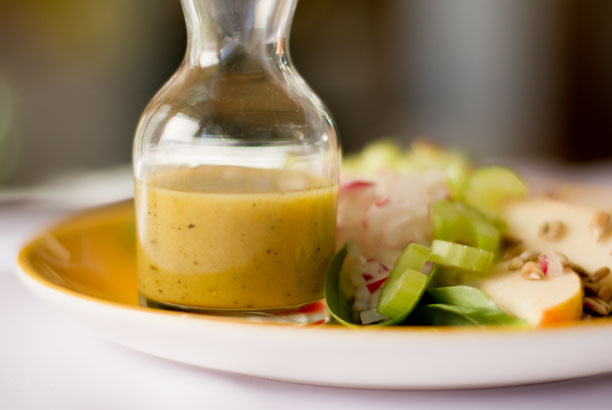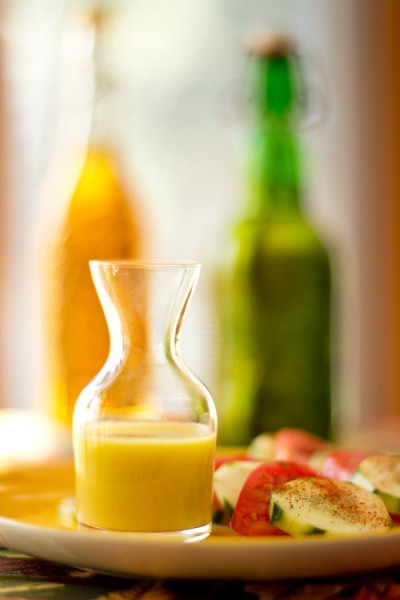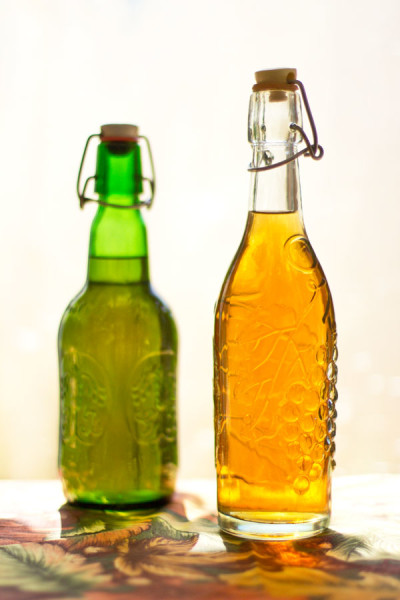
A vinaigrette is a mixture of oil and vinegar (or something acidic) that is used as a salad dressing or marinade. It’s such a simple condiment that there is no reason that you can’t make your own rather than buying. Making your own vinaigrette not only saves a ton of money, it also offers you the ability to create a vinaigrette that best complements a particular salad. It takes about 3 minutes to make and you can make just enough for one salad. The time for throwing out bottles of unused salad dressings because the oil has gone bad is over.
Below are the general rules that I follow when I make my own vinaigrette.
- Use a 3 to 1 ratio of oil to vinegar. If you like a more acidic dressing, use an oil to vinegar ratio of 2.5:1. Of course this ratio is easy to adjust to your personal taste.
- Add a teaspoon of a mustard/mayonnaise for flavor and to achieve a better emulsion. From what I’ve read the mustard attaches to the oil and helps to suspend it in the vinegar for a longer period of time. A little bit of mustard/mayonnaise also allows you to cut back on the oil a bit.
- A little water in an oil and vinegar dressing also helps to suspend the emulsion for a little bit longer.
- Lemon or lime juice can be used in place of or as part of the vinegar.
- Mayonnaise, yogurts, buttermilk or combinations of can be used in place of all or some of the oil.
- Honey or maple syrup adds a little sweetness to the dressing and can help to eliminate some of the bite that the vinegar adds. However, be careful because a little bit of honey or maple syrup goes a long way and you don’t want your dressing to be too sweet. Start with 1/2 tsp. and go from there.
- Balsamic vinegars are normally sweeter than other types of vinegar; therefore, you don’t get as much acidity as from other vinegars (IMO).
- Whisk together the vinegar (and acid components), mustard, and sweetener before adding the oil.
- Add the oil and whisk to an emulsion. After whisking in the oil, always taste for acidity and adjust if needed.
- A small bowl and a whisk work best (IMO).
- Add other ingredients such as herbs and spices.
- Because a salad dressing is so easy to make, only make what you need at the time. Homemade salad dressings get “old” after a couple of days in the fridge because there are no preservatives as you’ll find in store bought dressings.
Oil and Vinegars for vinaigrettes
- White wine vinegar
- Red wine Vinegar
- Homemade Peppered Cucumber Vinegar
- Rice Vinegar
- Apple cider vinegar
- Balsamic vinegar
- Champagne vinegar
- Infused vinegars
- Infused White balsamic vinegars
- Extra-Virgin Olive Oil
- Canola Oil
- Walnut Oil
- Infused Olive Oil
Other ingredients for homemade vinaigrettes
- Honey or maple syrup
- Mustard (e.g., yellow, Dijon, Gourmet)
- Mayonnaise
- Buttermilk
- Yogurt
- Fresh or dried herbs (a little mint works wonders)
- Minced garlic or shallots
- Sea salt
- Spices (e.g., chile powders, curry powder)
My Basic Oil and Vinegar Vinaigrette Recipe
- 1 tsp. Dijon or Creole mustard
- 1 Tbsp. infused White Balsamic Vinegar
- Pinch of sea salt
- 3 Tbsp. olive oil
Links to Other Salad Dressings (for some of these, you’ll need to look in the related recipe)




